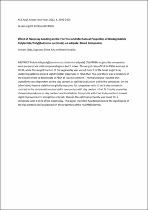 ResearchSpace
ResearchSpace
Effect of nanoclay loading on the thermal and mechanical properties of biodegradable Polylactide/Poly[(butylene succinate)- co-adipate] blend composites
JavaScript is disabled for your browser. Some features of this site may not work without it.
- ResearchSpace
- →
- Research Publications/Outputs
- →
- Journal Articles
- →
- View Item
| dc.contributor.author |
Ojijo, Vincent O

|
|
| dc.contributor.author |
Ray, Suprakas S

|
|
| dc.contributor.author |
Sadiku, R

|
|
| dc.date.accessioned | 2013-01-28T08:45:15Z | |
| dc.date.available | 2013-01-28T08:45:15Z | |
| dc.date.issued | 2012-04 | |
| dc.identifier.citation | Ojijo, V., Ray, S.S. and Sadiku, R. 2012. Effect of nanoclay loading on the thermal and mechanical properties of biodegradable Polylactide/Poly[(butylene succinate)- co-adipate] blend composites. ACS Applied Materials & Interfaces, vol. 4(5), pp. 2395-2405 | en_US |
| dc.identifier.issn | 1944-8244 | |
| dc.identifier.uri | http://pubs.acs.org/doi/pdf/10.1021/am201850m | |
| dc.identifier.uri | http://pubs.acs.org/toc/aamick/4/5 | |
| dc.identifier.uri | http://hdl.handle.net/10204/6468 | |
| dc.description | Copyright: 2012 ACS Publications. This is an ABSTRACT ONLY. | en_US |
| dc.description.abstract | Polylactide/poly[(butylene succinate)-co-adipate] (PLA/PBSA)-organoclay composites were prepared via melt compounding in a batch mixer. The weight ratio of PLA to PBSA was kept at 70:30, while the weight fraction of the organoclay was varied from 0 to 9%. Small angle X-ray scattering patterns showed slightly better dispersion in PBSA than PLA, and there was a tendency of the silicate layers to delaminate in PBSA at low clay content. Thermal analysis revealed that crystallinity was dependent on the clay content as well its localization within the composite. On the other hand, thermal stability marginally improved for composites with <2 wt % clay content in contrast to the deterioration observed in composites with clay content >2 wt %. Tensile properties showed dependence on clay content and localization. Composite with 2 wt % clay content showed slight improvement in elongation at break. Overall, the optimum property was found for a composite with 2 wt % of the organoclay. This paper therefore has demonstrated the significance of the clay content and localization on the properties of the PLA/PBSA blends. | en_US |
| dc.language.iso | en | en_US |
| dc.publisher | ACS Publications | en_US |
| dc.relation.ispartofseries | Workflow;10127 | |
| dc.subject | Clay loading | en_US |
| dc.subject | PLA/PBSA blend | en_US |
| dc.subject | Blend composites | en_US |
| dc.title | Effect of nanoclay loading on the thermal and mechanical properties of biodegradable Polylactide/Poly[(butylene succinate)- co-adipate] blend composites | en_US |
| dc.type | Article | en_US |
| dc.identifier.apacitation | Ojijo, V. O., Ray, S. S., & Sadiku, R. (2012). Effect of nanoclay loading on the thermal and mechanical properties of biodegradable Polylactide/Poly[(butylene succinate)- co-adipate] blend composites. http://hdl.handle.net/10204/6468 | en_ZA |
| dc.identifier.chicagocitation | Ojijo, Vincent O, Suprakas S Ray, and R Sadiku "Effect of nanoclay loading on the thermal and mechanical properties of biodegradable Polylactide/Poly[(butylene succinate)- co-adipate] blend composites." (2012) http://hdl.handle.net/10204/6468 | en_ZA |
| dc.identifier.vancouvercitation | Ojijo VO, Ray SS, Sadiku R. Effect of nanoclay loading on the thermal and mechanical properties of biodegradable Polylactide/Poly[(butylene succinate)- co-adipate] blend composites. 2012; http://hdl.handle.net/10204/6468. | en_ZA |
| dc.identifier.ris | TY - Article AU - Ojijo, Vincent O AU - Ray, Suprakas S AU - Sadiku, R AB - Polylactide/poly[(butylene succinate)-co-adipate] (PLA/PBSA)-organoclay composites were prepared via melt compounding in a batch mixer. The weight ratio of PLA to PBSA was kept at 70:30, while the weight fraction of the organoclay was varied from 0 to 9%. Small angle X-ray scattering patterns showed slightly better dispersion in PBSA than PLA, and there was a tendency of the silicate layers to delaminate in PBSA at low clay content. Thermal analysis revealed that crystallinity was dependent on the clay content as well its localization within the composite. On the other hand, thermal stability marginally improved for composites with <2 wt % clay content in contrast to the deterioration observed in composites with clay content >2 wt %. Tensile properties showed dependence on clay content and localization. Composite with 2 wt % clay content showed slight improvement in elongation at break. Overall, the optimum property was found for a composite with 2 wt % of the organoclay. This paper therefore has demonstrated the significance of the clay content and localization on the properties of the PLA/PBSA blends. DA - 2012-04 DB - ResearchSpace DP - CSIR KW - Clay loading KW - PLA/PBSA blend KW - Blend composites LK - https://researchspace.csir.co.za PY - 2012 SM - 1944-8244 T1 - Effect of nanoclay loading on the thermal and mechanical properties of biodegradable Polylactide/Poly[(butylene succinate)- co-adipate] blend composites TI - Effect of nanoclay loading on the thermal and mechanical properties of biodegradable Polylactide/Poly[(butylene succinate)- co-adipate] blend composites UR - http://hdl.handle.net/10204/6468 ER - | en_ZA |





